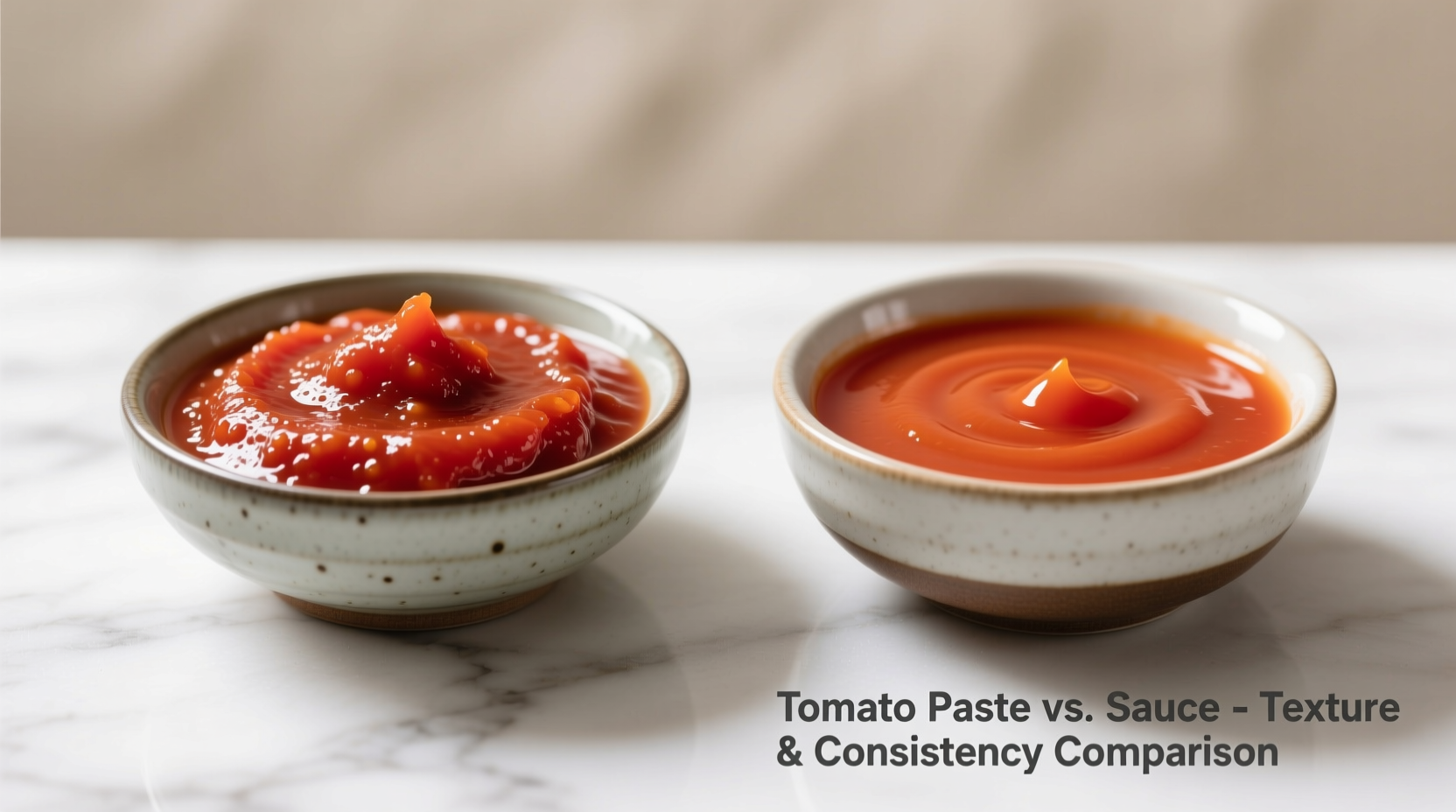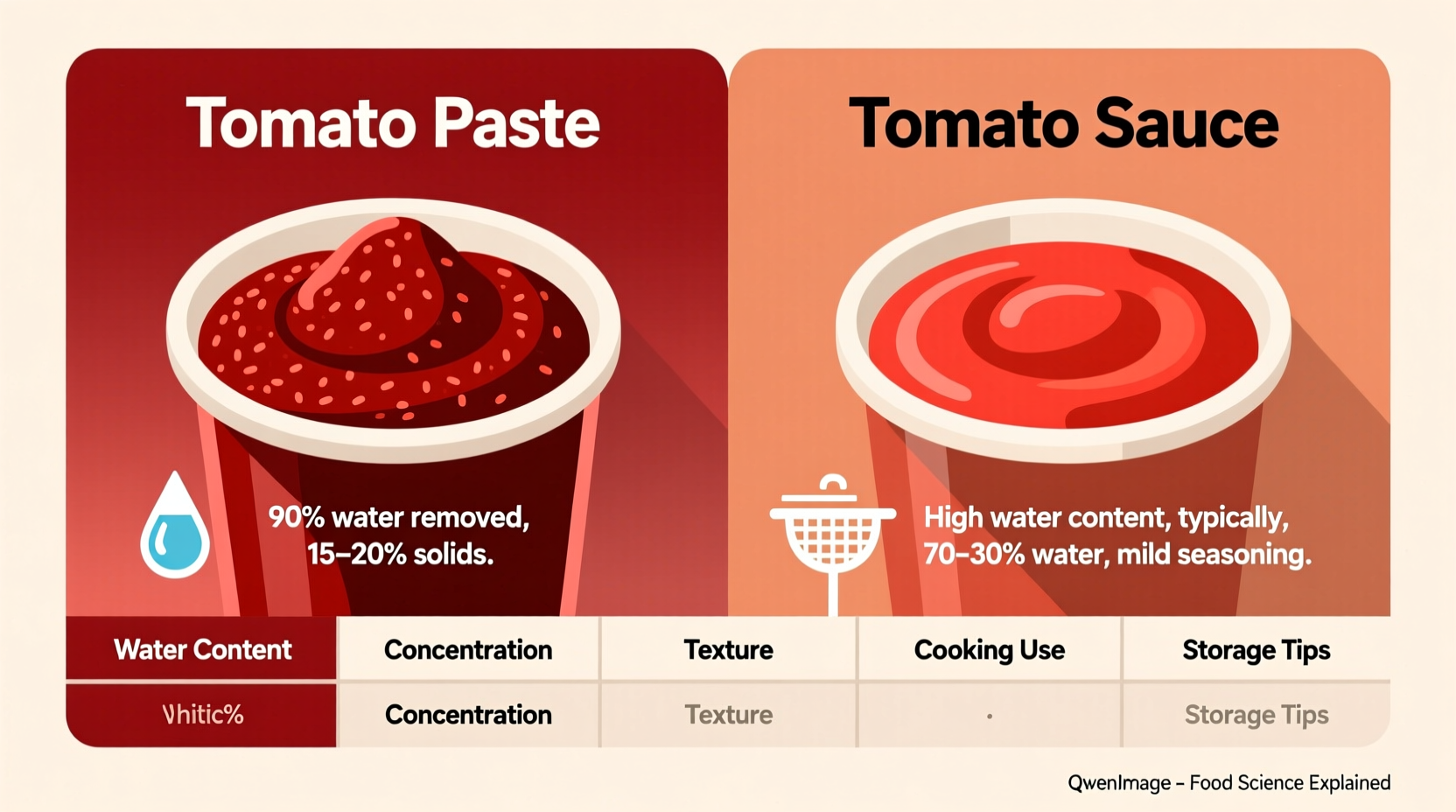Ever reached for tomato sauce when your recipe called for paste—or vice versa—and ended up with a watery stew or overly thick pasta sauce? You're not alone. This comprehensive guide breaks down the critical distinctions between these two essential pantry staples, helping you master their proper applications in everyday cooking.
Core Differences at a Glance
| Characteristic | Tomato Paste | Tomato Sauce |
|---|---|---|
| Solids Content | 24-30% (USDA FoodData Central) | 8-12% (USDA FoodData Central) |
| Texture | Thick, almost paste-like consistency | Pourable, similar to heavy cream |
| Ingredients | Pure tomatoes (sometimes with citric acid) | Tomatoes, water, seasonings, sugar, citric acid |
| Cooking Time Needed | Requires 5-10 minutes cooking to mellow flavor | Ready to use immediately |
| Primary Culinary Function | Thickening agent and flavor concentrator | Base for quick sauces and soups |
Why Concentration Matters in Your Cooking
The solids content difference isn't just technical jargon—it directly impacts your cooking results. Tomato paste's high concentration means it delivers intense umami flavor without adding excess liquid to your dish. Professional chefs often sauté tomato paste in oil for 5-7 minutes before adding other ingredients, a technique called "cooking out" that eliminates any metallic taste and deepens the flavor profile.
Tomato sauce, with its higher water content, serves as a convenient base that requires minimal additional preparation. However, this convenience comes at a cost—you're paying for water weight and often getting preservatives and added sugars you might not want in your dish.

When to Use Each Product: Practical Applications
Understanding the difference between tomato paste and sauce in recipes prevents common kitchen disasters. Here's when to reach for each:
Reach for Tomato Paste When:
- You need to thicken sauces, soups, or stews without diluting flavor
- Building foundational flavor in dishes like braises or ragùs
- Creating restaurant-quality pizza sauce (dilute with a splash of water)
- Adding depth to meatloaf or meatball mixtures
Choose Tomato Sauce When:
- Preparing quick weeknight pasta dishes
- Creating simple marinara in under 20 minutes
- Need a ready-to-use base for casseroles
- Time-constrained cooking where minimal prep is essential
Avoid These Common Substitution Mistakes
While you can substitute one for the other in a pinch, doing so without adjustments often leads to disappointing results. The tomato paste vs sauce substitution ratio requires careful consideration:
- Using sauce instead of paste: You'll need to reduce excess liquid by simmering longer, which can overcook other ingredients. For every 2 tablespoons of paste required, use ½ cup sauce and simmer uncovered for 15-20 minutes.
- Using paste instead of sauce: Dilute with water or broth at a 1:3 ratio (1 part paste to 3 parts liquid). Add seasonings to compensate for the lack of herbs found in most commercial sauces.
Food science research from the Culinary Institute of America confirms that improper substitution alters the Maillard reaction during cooking, affecting both flavor development and final texture. This explains why many home cooks end up with either watery or overly thick sauces when they interchange these products without adjustment.
Professional Chef Tips for Maximum Flavor
As someone who's worked in both professional kitchens and taught home cooking classes, I've seen these techniques transform ordinary dishes:
- Store leftover paste properly: Freeze in ice cube trays (2-tablespoon portions) for easy future use—thaw directly in your dish
- Enhance store-bought sauce: Add 1-2 tablespoons of paste per cup of sauce and simmer 10 minutes for richer flavor
- Check ingredient quality: Opt for tomato paste with only "tomatoes" listed—avoid added sugar or citric acid when possible
- Use paste as a flavor booster: Stir a teaspoon into scrambled eggs or mashed potatoes for subtle umami enhancement
Remember that tomato paste and sauce differences in cooking applications extend beyond simple texture. The concentration level affects how flavors meld with other ingredients during the cooking process. High-quality paste creates a flavor foundation that builds complexity, while sauce delivers immediate but less intense results.
When Substitution Isn't Advisable
While substitutions work in many cases, certain dishes absolutely require the specific properties of one product:
- Never substitute sauce for paste in recipes where liquid content is critical, like pizza sauce or concentrated reductions
- Avoid using paste instead of sauce in delicate dishes like tomato basil soup where the thinner consistency is essential
- Authentic Italian ragù requires the slow caramelization of tomato paste to develop its signature depth
Understanding these context boundaries for tomato paste versus sauce prevents recipe failures and helps you make informed decisions based on your specific cooking needs.











 浙公网安备
33010002000092号
浙公网安备
33010002000092号 浙B2-20120091-4
浙B2-20120091-4